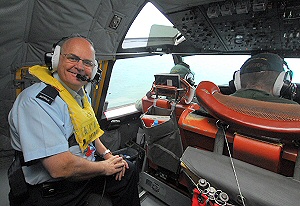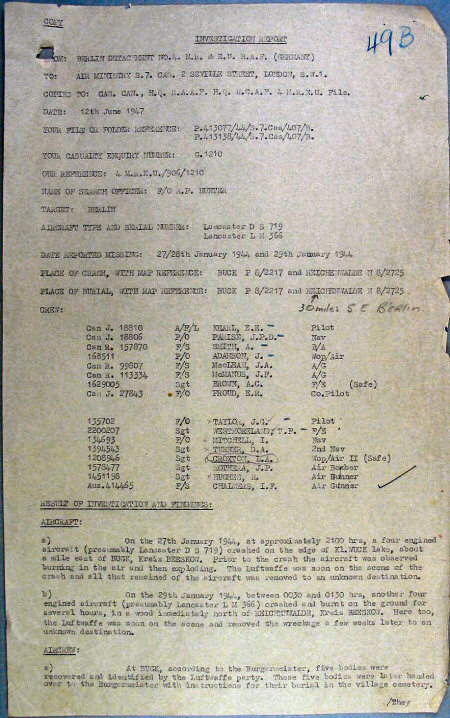207 SQUADRON ROYAL AIR FORCE HISTORY
The loss of Lancaster LM366 EM-H
The Taylor crew - Berlin, 29 Jan 1944
 This image, via Karsten Schulze, is a representation of an earlier EM-H. LM366 would have had an H2S scanner blister ventrally mounted under the roundel: the code letters would probably have been red, not white. The aircraft serial LM366 would have been shown in small red characters between the aircraft code letters and the tail unit. |
Lancaster LM366 EM-H was lost on an operation on Berlin. It took off from RAF Spilsby, Lincolnshire at 0003hrs, 29th January 1944.
The aircraft LM366 EM-H (H for Harry in those days), was a Mk III Lancaster, which arrived on the Squadron in September 1943 and had done 145.2 hours of flying when lost. [source: Raymond Glynne-Owen]
The crew was as follows:
Pilot: Flt
Lt John Gordon Taylor RAF(VR) +
Flight Engineer: Sgt
Thomas Fowler Westmoreland RAF(VR) +
Navigator: F/O
Ivor Mitchell RAF(VR) +
Wireless Operator: Sgt Leo Arthur Croxton RAF(VR) pow
Bomb Aimer: Sgt
John Patrick Rothera RAF(VR) +
Mid Upper: Sgt
Robert Hughes RAF(VR) +
Rear Gunner: F/Sgt
Ivor Frederick Chalmers RAAF +
2nd Navigator: Sgt
Donald Arthur Turner RAF(VR) +
+ killed in action
According to the published 207 Squadron history, Always Prepared, of the 11 aircraft detailed for that operation, six failed to take off: of the five that did go all returned except the Taylor crew. The reason for the six failing to take off is that Dick Burnet's aircraft got bogged and blocked them from being able to take off.
Leo Croxton was severely injured, taken POW, and was in Camp 357 (Stalag Kopernikus), pow no. 3547 (source: Chorley)
The Pilot, Flight Engineer and Rear Gunner are buried in the Berlin (1939-45) War Cemetery, where they lie next to each other (click on the link and then view the cemetery photo; according to the cemetery plan the three graves in plot 5 row D are close by the view shown):
John Taylor, the son of Ernest Maurice and Annie Eleanor Mabel Taylor, of Esher, Surrey, was aged 21. John is in grave ref 5. D. 9. - see also on the 207 website Memorials > Those on local war memorials
| Ivor Chalmers,
aged 32, was the son of the late Alexander Chalmers and Emily
Mary Chalmers, of Samford, Queensland, Australia. He is in
grave 5.D.10.
Ivor was a Timber worker of North Tamborine, Queensland. He enlisted at Traveston near Gympie in Queensland and spent some time in Canada training, prior to posting in the UK. His original place of burial was in the parish cemetery at Buck. One of his nephews is F/O Bruce Chalmers, a Reservist with 23 Sqn RAAF: photo taken in an Orion aircraft over the Great Australian Bight.
|
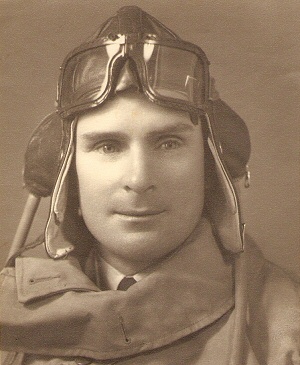 Ivor Chalmers: source Bruce Chalmers |
Bruce writes 20 July 2008: Uncle Ivor is commemorated on the walls of the Australian War Memorial and proudly and fondly remembered by his family. The family consisted of Ivor, Don (Army), Roy (RAAF), John (Army - a Desert Rat at Tobruk), Ben (RAAF and my father Thomas (RAAF) and Joyce. Joyce is the only surviving member of the family and lives not far from the family home at North Tamborine.
I am the only member of the extended descendants of the family to serve in the RAAF so I carry a great honour in fulfilling that role - even though only a reservist - and upholding Uncle Ivor's memory. I hope one day to visit his war grave and now I know where 207 was based, hopefully his UK base as well. Ivor was 32 years old when killed and I have always thought that it was a mature age to be involved in the conflict, but the War was a different time and it is difficult for those of us born later to understand just how different it was. Mind you, I joined at age 53, only two and a half years ago.
Tom Westmoreland, son of George S. Westmoreland and Gladys Westmoreland, of Headingly, Leeds, Yorkshire, was aged 20, and is in grave 5.D.11
Information received from Germany (see below) states that five bodies were recovered from the crash site: the two unidentified bodies are stated to be in graves 5.D.12 and 5.D.13 in the Berlin (1939-45) War Cemetery. Thus the five dead who were found are all together.
The names of the four who have no known grave (that is, the two who were not found and the two it was not possible to identify) are inscribed on the Air Forces Memorial at Runnymede:
John (Pat) Rothera, no age given, was the son of Wilfred Stewart and Dulcie Alice Rothera, of Nottingham. His name is on panel 237

| Donald Turner,
aged 22, was the son of Herbert and Kate Turner, of Belvedere,
Kent.
His name is on panel 239. His niece Carol Peachey contacted the Association in March 2007: My late father was Donald Turner's younger brother. My mother recently found the notification of death sent to Donald's parents. It was inside what we think was his Donald's degree thesis. We think that his mother Kate hid the notification in the thesis and both have remained unopened in a box since Donald died. Certainly none of us knew that he had died at Reichenwalde. I feel my father would have visited the site had he known. My mother remembers that he spent a year in Canada training after he finished his Degree. He was then sent to Lincolnshire where we think his half sister Joan Wells (who possibly called herself Joan Bennett) was also stationed. She was in the WAAF. His flight with the Taylor crew was his first and only flight. We would be very grateful for any information about Donald. |
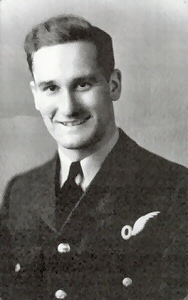 Donald Turner, taken in Moncton, New Brunswick, the location of 8SFTS: source Peachey |
Robert Hughes, aged 25, was the son of Edward and Mary Jane Hughes, of Rhos, Denbighshire. His name is on panel 231.
Ivor Mitchell, no next of kin or age information given, is on panel 208.
WR (Bill) Chorley's RAF Bomber Command Losses of the Second World War, for 1944 (published by Midland Counties Publishing 1997, ISBN 0 904597 91 1) p59 adds "Believed to have crashed at Reichenwalde, 4km ENE of Storkow. Those who died were [initially] buried on 30 January at the crash site". [clicking on Reichenwalde links to a map]
Laurie Barnes, also on 207 Squadron, was shot down on Berlin the following night. He was taken to the Hermann Goering Luftwaffe Lazarett at Gatow: "Here I came across someone vaguely familiar, encased in plaster. We struck up a careful conversation, establishing indirectly that we were both on 207 by talking about a barman known only to the Squadron. I believe I was talking to Leo Arthur Croxton." Leo's widow Betty and son Lee are Friend Members of the Association.
Leo died just a short while before the Association was able to make effective contact with the Croxton family. He had been ill for some time which might explain why Michael Westmoreland did not hear from him when trying to make contact. Leo's son Lee said that his father regretted losing touch with the rest of the crew.
Michael Westmoreland, Tom Westmoreland's brother, has always been intrigued as to how Leo Croxton survived. He says that in a letter to Michael's mother written when Leo was repatriated, he said he had a total amnesia about the raid and woke up in hospital; he was told that he had been found in the wreckage of the plane. As none of the other crew survived it must be surmised that no-one had time to bail out, and the position of the crash site (on the turn after the bombing run) suggests the plane probably fell out of the sky from 20,000 ft. Such a catastrophic event is of course normally totally unsurvivable.
| Michael has provided a photo which
shows three of the crew. Identifications so far are L-R:
Flight Engineer Tom Westmoreland, ??Wireless Op Leo Croxton,
?, ?, ?Bomb Aimer Patrick Rothera.
The one of two un-named may be air gunner Robert Hughes (Bruce Chalmers does not recognise Ivor Chalmers RAAF in this photo). Not shown are the pilot John Taylor and Navigator Ivor Mitchell. Michael reasons that the photo was taken in warm weather, hence possibly at Langar in the very late Summer/Autumn of 1943 |
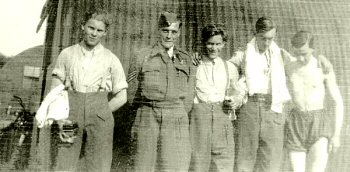 |
Also a Friend member of the Association is Ivor Mitchell's granddaughter Kotska Wallace, now a scientist with the European Space Agency. Michael Westmoreland says: "I met Ivor Oddie and his mother at Scarborough in 1945 when he was about 12 months old."
John Rothera's niece Jane Bealby and nephews Dudley and Martin Walker are also Friend members of the Association, as is Tony Brown, who worked with John Rothera's father.
Kevin Hughes, second cousin of Robert Hughes the Mid-Upper Gunner, is also a Friend member of the Association.
Association member The Rev Harry Orchard, then Flying Control Officer at Spilsby, says: "John Taylor was a friend. We used to go on occasional trips to Skegness together during the "moon periods" when the Squadron might have a short break and I could also get a few hours off."
Some of the relatives of the crew met at dedication of trees at East Kirkby on 14th August 2003. One of the saplings was dedicated to all who served on 207 Squadron. There was a flypast by aircraft of the present day 207 Squadron:
| Rev Harry Orchard
with some of the families of the crew of his great friend at
Spilsby, John Taylor, lost on Berlin on 29th January 1944 in
Lancaster EM-H LM366, from which there was only one
survivor, the late Leo Croxton.
L-R: Jo Oddie, next to her husband Ivor Oddie, son of Ivor Mitchell, the Navigator; Harry Orchard; Michael Westmoreland, brother of Tom, the Flight Engineer and Jane Bealby, niece of John (Pat) Rothera, the Air Bomber. Two other families from this crew include Friend members of the Association who were unable to attend. |
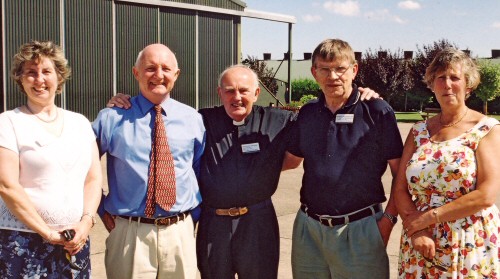 |
Karsten Schulze in OT Nahmitz, Germany, has been investigating with others the loss of some Bomber Command aircraft. He has provided these images of items found at the crash site of LM366 in a woodland area north of Reichenwalde.
On his website is a report taken by his colleague Peter Reinhardt from Mrs S. from Silberberg, who recalled what she was told at the time:
"At that time I was 15 years old. To the plane crash I can remember myself only from hear remind. By the crash an airman was seriously injured. He fell through the roof of a barn in the Dachsberg. Today only the foundations are to be seen there. This airman was rescued by the SS and was brought by an ambulance in a military hospital, he should probably died later from the injuries. At the past I have graduated my duty year from on the farm at Dachsberg. The other airmen were buried in Reichenwalde in the local cemetery and were dug out later again and brought to England." [in fact the crew now rest in the 1939-1945 War Cemetery in Berlin. (KS)]
He also provides an eyewitness account of the crashing of the aircraft, from Herr Norbert K., senior, of Reichenwalde (again taken by Peter Reinhardt):
"I was eight years old at the time of the crash. Billeted in my parents’ house at the time were some SS soldiers who had just taken part in manoeuvres in the Storkow area. I still recall the incident quite vividly. Unterscharführer Gericke, one of the SS men, told my parents and me that the crew was Canadian. Gericke wanted to give me a wrist-watch taken from one of the airmen but my father declined his offer.
There were seven dead airmen. The sole survivor was lucky enough to land on a dung heap at Silberberg farm, which saved his life. He broke both his legs in the fall and was captured by the SS. The SS removed the wreckage of the bomber from the crash site. They also looted the airmen’s personal possessions and flying suits. I remember the airmen’s trousers and jackets were made of leather and could be heated electrically.
The soldiers buried the seven corpses in a joint grave in the rear left-hand corner of the Waldfriedhof cemetery and erected a single birch cross. I remember one of the corpses still being in a sitting position as it lay in the grave – a terrible sight, the sort of thing that remains with you for the rest of your life. The SS had simply thrown the corpses from the truck into the hole, filled it with earth, and then erected the cross.
Possibly around 1946-47 (I don’t recall exactly when) the English exhumed the bodies and took them away somewhere [for reburial at the War Cemetery, Berlin (KS)]. They cordoned off the cemetery to prevent anyone watching.
The bomber was flying from NW to SE just before it crashed. It then turned markedly to the left and emerged - on fire - from the clouds. The main part of the fuselage ended up on Mittelfeld (Centre field) behind the Waldfriedhof cemetery. It burnt out. One of the engines lay in the nearby wood together with a machine-gun turret. The whole area was scattered with ammunition. My friends and I tried to fire a machine gun we found but it refused to work. When my father found out he gave me good hiding!
The rear of the bomber came to rest close to the sports field. The body of a dead airman lay nearby. For many years following the crash Mittelfeld was unable to be farmed because of all the burning and contamination. Much later when I was ploughing the field I’d continually rake up items such as lengths of thin pipe and small hydraulic pumps. These were dumped at the collective farm and then removed for scrap. I can’t imagine that anyone in the area has any aircraft parts in their possession because the SS cleared the crash site so thoroughly."
Investigation Report: 2 June 1947, made by the Berlin Detachment No.4, MR & EU RAF (Germany)
The above eyewitness report from Herr Norbert K. snr, which talks of seven bodies, should be compared with the following report, 12 June 1947, made by the Berlin Detachment No.4 Missing Research & Enquiry Unit RAF (Germany), which says only five bodies were recovered from the collective grave at Reichenwalde. (source: National Archives of Australia, via Karsten Schulze):
Evidently, later investigation enabled identification
sufficient to permit
the named burials of John Taylor, Ivor Chalmers and Tom Westmoreland.
Wreckage item images - via Karsten Schulze - taken
by Peter Reinhardt.
The parts were found May 2004: the scales are in cm.
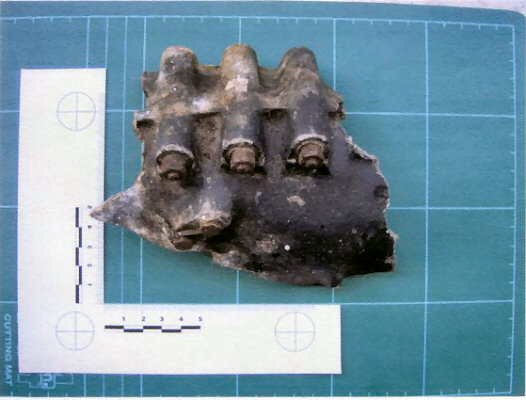
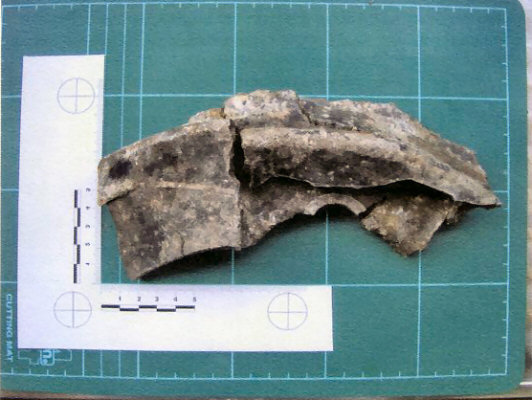
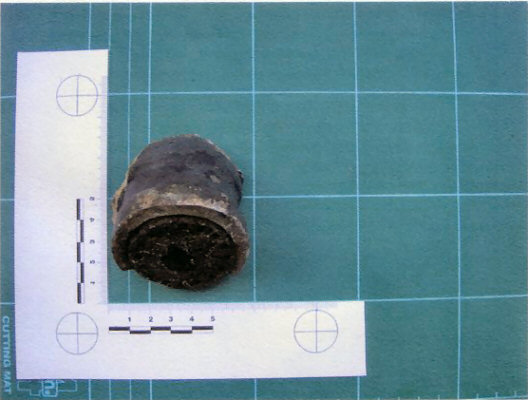
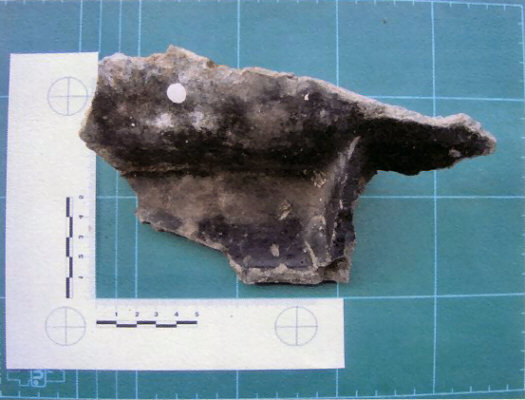
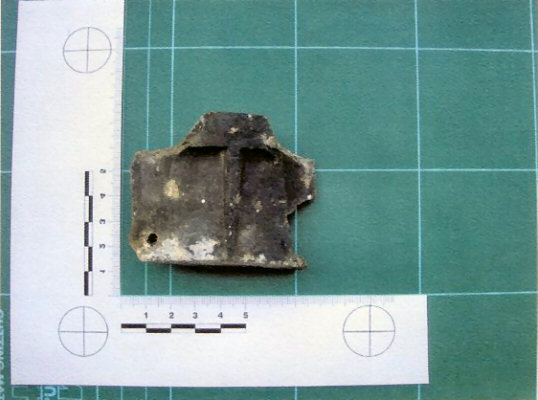
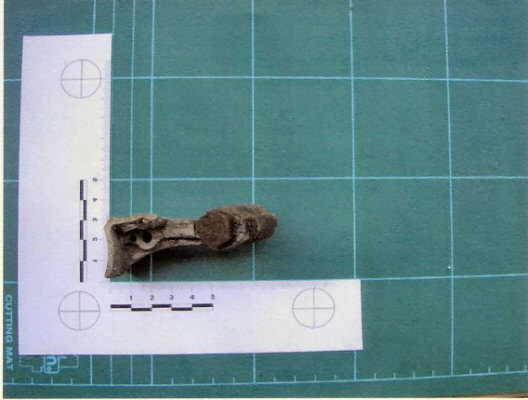
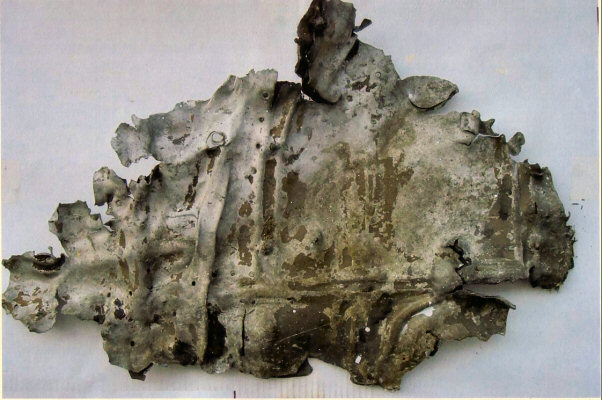
Please contact the editor if you have further information to add to this page or you are a member of the family of the Pilot: Flt Lt John Gordon Taylor RAF(VR) .. or if you knew any of the crew.
visit the websites hosted by 207 Squadron RAF History at www.rafinfo.org.uk
page last updated 26 July 2008: 23 Dec 13: 18 Nov 17
